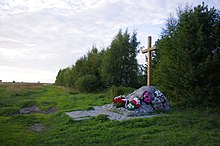Poles in Buryatia
 Monument to Polish exiles, insurgents of the Baikal Insurrection, in Rechka Mishikha, before 2023 destruction | |
| Total population | |
|---|---|
| 170[1] (2010, census) |
Poles in Buryatia form part of the Polish diaspora in Siberia. Polish presence in Buryatia dates back over 300 years.[2]
History
| Year | Pop. | ±% |
|---|---|---|
| 1926 | 1,241 | — |
| 1939 | 726 | −41.5% |
| 1959 | 391 | −46.1% |
| 1970 | 363 | −7.2% |
| 1979 | 388 | +6.9% |
| 1989 | 894 | +130.4% |
| 2002 | 249 | −72.1% |
| 2010 | 170 | −31.7% |
| Sources:[3][4][5][6][7][8][1] | ||
One of the first Poles in Buryatia was Nicefor Czernichowski.[2] In 1764, nine either Poles or people of Polish descent was registered in Udinsk. Following the Partitions of Poland, Russia deported many Poles, political prisoners, members of the secret Polish resistance and insurgents, as well as ordinary criminals, to katorga in Siberia, including Buryatia.[9] In 1859–1862, exiled Aleksander Zenowicz, was the mayor of Kyakhta.[10]
The Polish Baikal Insurrection of 1866 also took place in Buryatia. Polish insurgents disarmed Russian convoys at Vydrino, Pereyomnaya and Mishikha, and then gathered in Mysovsk, before they clashed with Russian troops at Mishikha on 28 June 1866.[11] One of the leaders of the insurrection, Leopold Eljaszewicz, still lived near Verkhneudinsk as of 1883.[12]
Some Poles came to Buryatia voluntarily, including physician Julian Talko-Hryncewicz, who settled in Kyakhta and also conducted ethnographic and archeological work in the region.[13] The exiled Włodzimierz Zalewski was a city councillor of Verkhneudinsk in 1906–1908, and was one of the initiators of the construction of a Catholic church in Verkhneudinsk,[14] the sole such church in Buryatia. The church was consecrated in 1909, and Poles served as the first parish priests.[15] Sizeable Polish communities were founded in Mysovsk, Tankhoi and Vydrino along the Trans-Siberian Railway.[16] Polish exiles also popularized playing the piano in Buryatia.[17]
In the 1920s, most Poles left Buryatia for Poland, which just regained independence after World War I.[18] According to the 1926 Soviet census, there were 1,241 Poles in the Buryat-Mongol Autonomous Soviet Socialist Republic, constituting the seventh largest ethnic group of the republic.[3] In 1937–1938, remaining Poles were, like in other parts of the USSR, targeted by the Polish Operation of the NKVD.[18]
Culture
The main cultural organization of Poles in Buryatia is the National and Cultural Autonomy of Poles "Hope", based in Ulan-Ude, founded in 1993.[1][19] In 1996 it started publishing a Polish magazine Polaki w Burjatii in Ulan-Ude.[20]
The Polish exiles, insurgents of the Baikal Insurrection of 1866, were commemorated with a memorial in Rechka Mishikha in 2000, which was destroyed in 2023.
The Museum of History of Buryatia in Ulan-Ude contains works of Polish painter and exile to Siberia Leopold Niemirowski.[21]
References
- ^ a b c Siemionow 2015, p. 182.
- ^ a b Siemionow 2015, p. 172.
- ^ a b "Бурято-Монгольская АССР (1926)". Demoscope Weekly. Retrieved 10 January 2024.
- ^ "Бурят-Монгольская АССР (1939)". Demoscope Weekly. Retrieved 10 January 2024.
- ^ "Бурятская АССР (1959)". Demoscope Weekly. Retrieved 10 January 2024.
- ^ "Бурятская АССР (1970)". Demoscope Weekly. Retrieved 10 January 2024.
- ^ "Бурятская АССР (1979)". Demoscope Weekly. Retrieved 10 January 2024.
- ^ "Бурятская АССР (1989)". Demoscope Weekly. Retrieved 10 January 2024.
- ^ Siemionow 2015, p. 173.
- ^ "Zenowicz Aleksander". Encyklopedia PWN (in Polish). Retrieved 10 January 2024.
- ^ Владимир Поломошин. "НЕ СГИНЕЛА ПОЛЬСКА" (in Russian). Archived from the original on 28 September 2007. Retrieved 10 January 2024.
- ^ Stępień, Stanisław (2022). Leończyk, Sergiusz (ed.). Powstańcy styczniowi więzieni w twierdzy kijowskiej, Zarysy biogramów (in Polish and Ukrainian). Przemyśl: Południowo-Wschodni Instytut Naukowy. p. 9. ISBN 978-83-60374-41-2.
- ^ Siemionow 2015, pp. 177–178.
- ^ Siemionow 2015, p. 175.
- ^ Siemionow 2015, p. 176.
- ^ Siemionow 2015, p. 180.
- ^ Chernyshev, Artem (2019). "Muzyka i folklor polski na Syberii w XIX–XXI wiekach". In Leończyk, Sergiusz (ed.). Polacy na Syberii od XIX do XXI wieku (in Polish). Warszawa: Stowarzyszenie Wspólnota Polska. p. 56. ISBN 978-83-64206-39-9.
- ^ a b Siemionow 2015, p. 181.
- ^ Iwanowa, Maria (2019). "Promocja polskiej kultury w Buriacji". In Leończyk, Sergiusz (ed.). Polacy na Syberii od XIX do XXI wieku (in Polish). Warszawa: Stowarzyszenie Wspólnota Polska. p. 91. ISBN 978-83-64206-39-9.
- ^ Caban, Wiesław (2014). "Zsyłka Polaków na Syberię w XIX wieku. Przegląd publikacji polskich i rosyjskich/radzieckich". Przegląd Historyczny (in Polish). Vol. 105, no. 4. Wydawnictwo DiG. p. 108. ISSN 0033-2186.
- ^ Kosieradzki, Paweł (2019). "Oblicza syberyjskich wspomnień – różne formy na utrwalenie zesłania". In Leończyk, Sergiusz (ed.). Polacy na Syberii od XIX do XXI wieku (in Polish). Warszawa: Stowarzyszenie Wspólnota Polska. pp. 42–43. ISBN 978-83-64206-39-9.
Bibliography
- Siemionow, Jewgienij W. (2015). "Polacy w Buriacji – historia i współczesność". Niepodległość i Pamięć (in Polish) (2 (50)). Muzeum Niepodległości w Warszawie. ISSN 1427-1443.
